Pathophysiology (NSG5003)
South University
Page 2 out of 23 results
Sort by
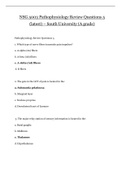
-
NSG 5003 Pathophysiology Review Questions 5 (latest) – South University (A grade)| Pathophysiology Review Questions 5 (2020) – (A grade)
- Exam (elaborations) • 4 pages • 2021
-
- $8.99
- + learn more
NSG 5003 Pathophysiology Review Questions 5 (latest) – South University (A grade) Pathophysiology Review Questions 5 1. Which type of nerve fibers transmits pain impulses? a. A-alpha (Aa) fibers b. A-beta (Ab) fibers c. A-delta (Ad) fibers d. B fibers 2. The gate in the GCT of pain is located in the: a. Substantia gelatinosa b. Marginal layer c. Nucleus proprius d. Dorsolateral tract of Lissauer
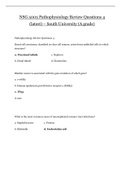
-
NSG 5003 Pathophysiology Review Questions 4 (latest) – South University (A grade)
- Exam (elaborations) • 4 pages • 2021
-
- $8.99
- + learn more
NSG 5003 Pathophysiology Review Questions 4 (latest) – South University (A grade) Pathophysiology Review Questions 4 Renal cell carcinoma, classified as clear cell tumors, arises from epithelial cells in which structure? a. Proximal tubule c. Nephron b. Distal tubule d. Glomerulus Bladder cancer is associated with the gene mutation of which gene? a. c-erbB2 b. Human epidermal growth factor receptor 2 (HER2) c. TP53 d. myc
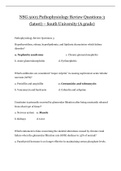
-
NSG 5003 Pathophysiology Review Questions 3 (latest) – South University (A grade)
- Exam (elaborations) • 3 pages • 2021
-
- $8.49
- + learn more
NSG 5003 Pathophysiology Review Questions 3 (latest) – South University (A grade) Pathophysiology Review Questions 3 Hypothyroidism, edema, hyperlipidemia, and lipiduria characterize which kidney disorder? a. Nephrotic syndrome c. Chronic glomerulonephritis b. Acute glomerulonephritis d. Pyelonephritis Which antibiotics are considered “major culprits” in causing nephrotoxic acute tubular necrosis (ATN)? a. Penicillin and ampicillin c. Gentamicin and tobramycin NSG 5003 Pa...
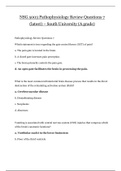
-
NSG 5003 Pathophysiology Review Questions 7 (latest) – South University (A grade) | NSG5003 Pathophysiology Review Questions 7 (latest)
- Exam (elaborations) • 4 pages • 2021
- Available in package deal
-
- $6.99
- + learn more
NSG 5003 Pathophysiology Review Questions 7 (latest) – South University (A grade) Pathophysiology Review Questions 7 Which statement is true regarding the gate control theory (GCT) of pain? a. The pain gate is located in the brain. b. A closed gate increases pain perception. c. The brain primarily controls the pain gate. d. An open gate facilitates the brain in processing the pain. What is the most common infratentorial brain disease process that results in the direct destruction of...

-
NSG 5003 Pathophysiology Review Questions 6 (latest) – South University (A grade) | NSG5003 Pathophysiology Review Questions 6 (latest)
- Exam (elaborations) • 4 pages • 2021
- Available in package deal
-
- $6.99
- + learn more
NSG 5003 Pathophysiology Review Questions 6 (latest) – South University (A grade) Pathophysiology Review Questions 6 A heat stroke is characterized by: a. Core temperatures usually reaching approximately 39.9° C (103.9° F) b. Sweat production on the face occurring even during dehydration c. A rapidly decreasing core temperature as heat loss from the evaporation of sweat ceases d. Symptoms caused by the loss of sodium and prolonged sweating Which medication is used to reverse th...
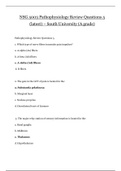
-
NSG 5003 Pathophysiology Review Questions 5 (latest) – South University (A grade) | NSG5003 Pathophysiology Review Questions 5 (latest)
- Exam (elaborations) • 4 pages • 2021
- Available in package deal
-
- $6.99
- + learn more
NSG 5003 Pathophysiology Review Questions 5 (latest) – South University (A grade) Pathophysiology Review Questions 5 1. Which type of nerve fibers transmits pain impulses? a. A-alpha (Aa) fibers b. A-beta (Ab) fibers c. A-delta (Ad) fibers d. B fibers 2. The gate in the GCT of pain is located in the: a. Substantia gelatinosa b. Marginal layer c. Nucleus proprius d. Dorsolateral tract of Lissauer 3. The major relay station of sensory information is located in the: a. Bas...
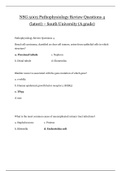
-
NSG 5003 Pathophysiology Review Questions 4 (latest) – South University (A grade) | NSG5003 Pathophysiology Review Questions 4 (latest)
- Exam (elaborations) • 4 pages • 2021
- Available in package deal
-
- $6.99
- + learn more
NSG 5003 Pathophysiology Review Questions 4 (latest) – South University (A grade) Pathophysiology Review Questions 4 Renal cell carcinoma, classified as clear cell tumors, arises from epithelial cells in which structure? a. Proximal tubule c. Nephron b. Distal tubule d. Glomerulus Bladder cancer is associated with the gene mutation of which gene? a. c-erbB2 b. Human epidermal growth factor receptor 2 (HER2) c. TP53 d. myc What is the most common cause of uncomplicated u...
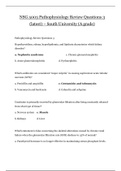
-
NSG 5003 Pathophysiology Review Questions 3 (latest) – South University (A grade) | NSG5003 Pathophysiology Review Questions 3 (latest)
- Exam (elaborations) • 3 pages • 2021
- Available in package deal
-
- $6.99
- + learn more
NSG 5003 Pathophysiology Review Questions 3 (latest) – South University (A grade) Pathophysiology Review Questions 3 Hypothyroidism, edema, hyperlipidemia, and lipiduria characterize which kidney disorder? a. Nephrotic syndrome c. Chronic glomerulonephritis b. Acute glomerulonephritis d. Pyelonephritis Which antibiotics are considered “major culprits” in causing nephrotoxic acute tubular necrosis (ATN)? a. Penicillin and ampicillin c. Gentamicin and tobramycin b. Vancomyc...
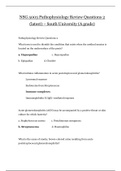
-
NSG 5003 Pathophysiology Review Questions 2 (latest) – South University (A grade) | NSG5003 Pathophysiology Review Questions 2 (latest
- Exam (elaborations) • 4 pages • 2021
- Available in package deal
-
- $6.99
- + learn more
NSG 5003 Pathophysiology Review Questions 2 (latest) – South University (A grade) Pathophysiology Review Questions 2 What term is used to identify the condition that exists when the urethral meatus is located on the undersurface of the penis? a. Hypospadias c. Hyperspadias b. Epispadias d. Chordee What initiates inflammation in acute poststreptococcal glomerulonephritis? Lysosomal enzymes Endotoxins from Streptococcus Immune complexes Immunoglobulin E (IgE)–mediated response...

How did he do that? By selling his study resources on Stuvia. Try it yourself! Discover all about earning on Stuvia


